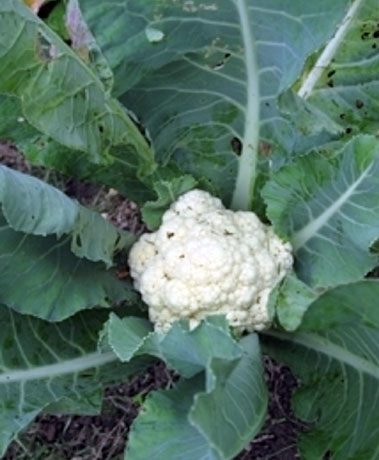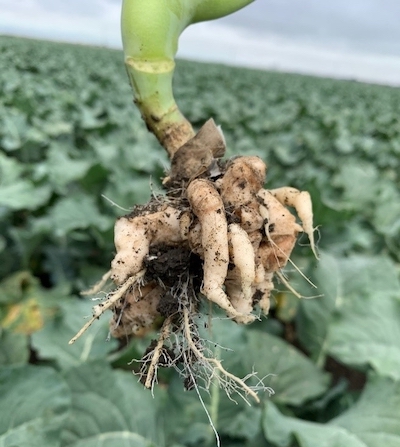Plant Brassicas Now for Fall Harvest and Holiday Dinners
By Janet Scheren, Fairfax Master Gardener Intern

Cauliflower
Yes, you can plant brassicas in the spring as well. But in the fall they grow into the cooler weather, allowing them to reach full maturity and size with vigor. For most of the brassicas, the cool weather — and for some, even light frost — sweetens their favor and enhances their texture. This dynamic allows for an extended growing season in the fall and an extra planting for most of these crops.
Temperature governs the growth and development of these healthful, beautiful and flavorful crops. It not only affects their ability to form tightly wrapped heads and leaves, or heads of flower buds and florets, but it also sets the timing for the plant going to seed, thus signaling the end of the plant’s productive life cycle. So, it’s important to get the timing right with these cole crops.
The best approach for Virginia gardeners is to start seeds indoors in late July or early August, thus providing 12 to 14 weeks before the first average frost date. For Northern Virginia’s USDA Zone 7a, the first frost date falls between October 14 and October 25. Use grow lights and a seed warming mat for best germination and seedling development. To minimize shock, use biodegradable pots made from materials such as peat, coir, manure, TP rolls, paper egg cartons or newspaper so that they can go right in the ground with your seedlings. Plant them when the seedlings are about 4 inches high, typically at about four weeks. You can also start with transplants from your local garden center.
This family of plants prefers a sunny location with rich, fertile soil that is slightly acidic to neutral. Brussels sprouts and cabbage prefer a pH ranging from 5.5 to 6.5. Broccoli and cauliflower like a slightly more neutral pH of 6.0 to 6.7. A bed with a pH of 6.0 to 6.5 meets the needs of all. While cabbage is a medium feeder, the others are heavy feeders and need starter fertilizer when transplanted and again two to four weeks later. All four of these plants come in a wide pallet of colors ranging all the way from white to shades of purple. Check online seed companies for descriptions of the many tasty and colorful varieties for each.
Here are some key tips for your brassica crops.

Sprouting purple broccoli
There are two types of broccoli — heading and sprouting. Heading broccoli forms a large central head and then side-sprouting branches after the main head is removed. Sprouting broccoli, also called Italian broccoli, forms many smaller heads. Harvest the florets before the flowers open or show yellow. Broccoli should be spaced 15 to 24 inches apart in rows 24 to 36 inches apart. The Virginia Cooperative Extension (VCE) recommends planting three to five plants per household member. Broccoli will mature in 60 to 100 days.
Brussels Sprouts
Extend your growing season by planting several varieties of Brussels sprouts, each with different maturity dates. This will allow a succession of harvest with one planting. The more cold-hearty varieties are the slower growing. Check the seed catalog or package for the days to maturity and count backward from the first frost date. Brussels sprouts are large plants, often 2 or 3 feet high, and need to be spaced 18 to 24 inches apart in rows 30 to 34 inches apart. VCE recommends planting two to five plants per household member. The sprouts develop at the leaf nodes and mature from the bottom of the stem to the top. You can twist off sprouts as they become firm and reach at least ½ inch in diameter or harvest the whole stock at one time. Use Brussels sprouts fresh or blanch and freeze halves after they have been trimmed and cleaned.
Cauliflower
Depending on the variety, cauliflower matures between 55 and 120 days from transplanting. Northern Virginia gardeners should typically select one of the quicker maturing varieties. Plants should be spaced 15 to 24 inches apart in rows 24 to 36 inches apart. VCE recommends planting three to five plants per household member. Temperature affects the texture and formation of cauliflower heads. Extended hot weather or lack of moisture produces malformed, grainy heads. When the flower head reaches about 2 to 3 inches, it’s time to secure the larger outer leaves around the head with a rubber band to shade it from the sun, which can discolor the floret or cause a bitter taste. This process is called blanching. Cauliflower should be harvested before the sections of the head begin to separate. Cauliflower can be preserved by freezing or pickling.

Clubroot in cabbage
Cabbage can grow from March to December in Virginia as it withstands temperatures as low as 15 to 20 degrees F. To produce large, robust heads, be sure to plant cabbage 15 to 18 inches apart in rows 30 inches apart. VCE recommends planting four to eight plants per household member. Cabbage is harvested when it reaches mature size, feels firm and when the outer leaves of the head begin to curl back. Reduce the risk of your cabbage head splitting open by keeping the soil evenly moist and not fertilizing after the head begins to firm. If a head does split, harvest and use it immediately.
Common Problems
These plants share common diseases and insect pests. Clubroot, fusarium wilt or black rot are the main disease concerns. Clubroot can be treated with 1 tablespoon of the fungicide PCNB (pentachloronitrobenzene) per gallon applied in transplant water. The fungal diseases can be treated with copper fungicide. You will need to guard against common pests as well. Weekly spraying with Bacillus thuringiensis (Bt), an organic/biological control, can keep cutworms and cabbage worms in check. Row covers can be used to keep cabbage root fly maggots, flea beetles, and aphids in check. Please refer to the 2020 Virginia Pest Management Guide for further information.
Resources
• Cole Crops or Brassicas, Virginia Cooperative Extension, Publication 426-403
• Virginia’s Home Garden Vegetable Planting Guide: Recommended Planting Dates and Amounts to Plant,
Virginia Cooperative Extension, Publication 426-331
• 2020 Virginia Pest Management Guide, Home Vegetables, Chapter 2, Publication 456-018, Virginia
Cooperative Extension
• Home Grown Pantry, by Barbara Pleasant, 2017
• Grow Great Virginia Vegetables, Ira Wallace, 2020